Martin Edwards's Blog, page 173
October 2, 2015
Forgotten Book - Evil Eye
One of the mysteries of crime fiction is why, even today, so few of the crime novels of Pierre Boileau and Thomas Narcejac have been translated into English. This was the duo who gave us Vertigo and Les Diaboliques, yet even when they were in their prime,in the Fifties, a good many of their collaborative novels went untranslated. And try laying your hands on an English language version of their earlier solo efforts...All very odd, for they were marvellous writers. I've featured their work several times on this blog, and today's Forgotten Book is Evil Eye, which Geoffrey Saintsbury translated in 1959.
It's a short novel, and the British hardback edition was bulked out by the inclusion of a novella called Sleeping Beauty, which I'll write about on another occasion (the UK paperback edition did not, I believe,include Sleeping Beauty for some reason.) The hardback is very difficult to find these days. When John Norris reviewed the book on his blog four years ago,(and an excellent and very enthusiastic review it was) I commented that I was keen to track down a copy myself. But I've only just managed to find one.
Was the book worth the wait? Yes, definitely. Boileau and Narcejac never repeated themselves, and yet somehow The Evil Eye is very characteristic of their work - one can't imagine it being written by anyone else. Their stories invariably have a touch of weirdness, and the plot is often so improbable that,in the hands of a less gifted writer, the result would be hopeless. But their work is always very readable.
Here, we have a young man, Remy, who is suddenly cured of his long-term paralysis by a healer. Once Remy can walk again and becomes independent, he becomes increasingly concerned by events in the past, which may in some way have caused the paralysis. The mood is menacing, and yet the reader can't be sure what is going on. The hallucinatory style of Boileau and Narcejac is very well captured in the translation. This isn't my favourite of their work - it's too slight, really, for that -, but it held my interest from start to finish.
It's a short novel, and the British hardback edition was bulked out by the inclusion of a novella called Sleeping Beauty, which I'll write about on another occasion (the UK paperback edition did not, I believe,include Sleeping Beauty for some reason.) The hardback is very difficult to find these days. When John Norris reviewed the book on his blog four years ago,(and an excellent and very enthusiastic review it was) I commented that I was keen to track down a copy myself. But I've only just managed to find one.
Was the book worth the wait? Yes, definitely. Boileau and Narcejac never repeated themselves, and yet somehow The Evil Eye is very characteristic of their work - one can't imagine it being written by anyone else. Their stories invariably have a touch of weirdness, and the plot is often so improbable that,in the hands of a less gifted writer, the result would be hopeless. But their work is always very readable.
Here, we have a young man, Remy, who is suddenly cured of his long-term paralysis by a healer. Once Remy can walk again and becomes independent, he becomes increasingly concerned by events in the past, which may in some way have caused the paralysis. The mood is menacing, and yet the reader can't be sure what is going on. The hallucinatory style of Boileau and Narcejac is very well captured in the translation. This isn't my favourite of their work - it's too slight, really, for that -, but it held my interest from start to finish.
Published on October 02, 2015 12:32
September 29, 2015
Inspirations for The Dungeon House

I said yesterday that I found the west Cumbrian setting of my latest Lake District Mystery, The Dungeon House, to be quite inspiring. Not just the tiny Roman port of Ravenglass, but the dunes and lonely beaches of Drigg, and the coastal resort of Seascale,which lies in the shadow of a massive nuclear plant. I enjoyed so much the experience of wandering around that area, and trying to see it through the eyes of my characters.

There were other inspirations for the storyline. Some time ago, I became fascinated by a terrible type of criminal, the so-called "family annihilator" who kills members of his family and then himself. I found myself wondering what could lead anyone to do something so dreadful that it is almost beyond comprehension. I didn't take any particular real life case as my starting point, but the general (and, sad to say, increasing) trend of family annihilation cases. But it's not giving too much away to say that the story evolves into something different - there's a reasonably convoluted whodunit plot, with a number of clues planted where I hope not many readers will be looking...
Two residents of Ravenglass, Neil Anderson and Mark A. Pearce, kindly gave me a good deal of insight into the lives that might be led by two of my invented characters, and this was a huge help. Mark is an artist, as is Scott Durham in the story, but he's a much finer artist than Scott! I have become a big fan of his, and one of his wonderful works of art - its subject Ravenglass, what else? - now adorns the living room chez Edwards. One of the many unexpected bonuses of life as a crime writer.
But sometimes inspiration takes a curious form. The original idea came to me after I paid a visit to an Arts and Crafts house in Cheshire, a couple of years ago. It boasted a wonderful quarry garden, and I felt as soon as I saw it that it would make a wonderfully evocative setting for murder most foul. And two years on, I'm still of the same opinion. Here's hoping that readers agree...



Published on September 29, 2015 09:24
September 28, 2015
The Dungeon House
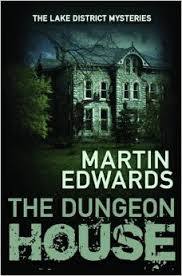
The Dungeon House is the seventh Lake District Mystery, and it has just been published in the UK, by Allison & Busby, and in the US, by Poisoned Pen. As usual with my series novels, I've tried to do something fresh while striving to retain the elements that have appealed to readers of the earlier books. And whilst it's tricky for an author to judge their own work, my feeling is that this is my favouiite in the series to date. This is the first novel I've written since ceasing to be a full-time lawyer, and I think the extra time spent crafting the story was beneficial.
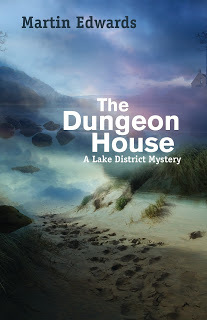
Another key factor, perhaps even more crucial, is that I found the location of the story absolutely inspiring. I've mentioned previously the research that I've undertaken in Ravenglass, and other parts of the west coast of Cumbria. By comparison with other parts of the Lake District, this is a relatively unfrequented area, yet it's rich in history and dramatic landscapes abound.

The first four chapters are set twenty years in the past. A man called Malcolm Whiteley (yet another character who owes his surname to a Derbyshire cricketer!) has made a fortune out of selling his business, and lives in the elegant Dungeon House, just above Ravenglass. But he suspects his wife Lysette (I created her after watching a stage play featuring Lysette Anthony, whose physical appearance helped me to get an image of the character clear in my mind) of having an affair. But is there really a mystery lover, or is it all in Malcolm's troubled mind?
A shocking crime is committed, and immediately the action switches to the present day. Hannah Scarlett and her team are investigating the disappearance, three years earlier, of a teenage girl. Then another girl goes missing, and it emerges that both cases have a curious link to events at the Dungeon House all those years ago. Meanwhile, a woman who was friendly with Malcolm Whiteley's daughter decides to return to Ravenglass, setting in motion a sequence of mysterious incidents. What on earth is going on? To find out, of course, you'll have to read the book!

Published on September 28, 2015 04:16
September 25, 2015
Forgotten Book - The Man Who Killed Himself
Starting in 1967, Julian Symons wrote three books with title beginning "The Man Who..." The first two, certainly, rank among his finest work, and it's no coincidence that when the Detection Club marked his 80th birthday with a collection of short stories in his honour, it was called The Man Who.., and each story had a title containing that phrase. The three books were not a trilogy, and are entirely distinct from each other. There are no common characters, although a strong sense of irony, and a sharp sense of humour, are common features.
The Man Who Killed Himself was the first of the three novels, and it features meek, unhappily married Arthur Brownjohn, a character who closely resembles Dr Bickleigh in Francis Iles' Malice Aforethought. This is not the only parallel between the two stories, and I've no doubt that Symons was consciously trying to take elements from the work of Iles (whom he admired, as I do) and fashion them into a contemporary mystery. He does so with great success. This is quite a short book, but it's genuinely gripping.
Arthur is leading a double life. He finds an outlet for the more, shall we say, outgoing aspects of his character by creating Major Easonby Mellon, a dodgy chap who runs a very dodgy matrimonial bureau. Mellon is married to a nice but unintelligent woman whom he has persuaded that he is actually a secret agent. The early scenes are very funny, but then the plot thickens - and it becomes progressively darker. Arthur, like the other 'Men Who...' is essentially a weak man, whose personality flaws make him a potential murderer.
Ultimately, this book is a study of a man's psychological disintegration. Symons had tackled this subject before, notably in The 31st of February, his first significant crime novel, and he would revisit it subsequently, but never with such zest as in this book. The combination of a clever plot and ironic prose is a real delight. I recommend it unreservedly.
The Man Who Killed Himself was the first of the three novels, and it features meek, unhappily married Arthur Brownjohn, a character who closely resembles Dr Bickleigh in Francis Iles' Malice Aforethought. This is not the only parallel between the two stories, and I've no doubt that Symons was consciously trying to take elements from the work of Iles (whom he admired, as I do) and fashion them into a contemporary mystery. He does so with great success. This is quite a short book, but it's genuinely gripping.
Arthur is leading a double life. He finds an outlet for the more, shall we say, outgoing aspects of his character by creating Major Easonby Mellon, a dodgy chap who runs a very dodgy matrimonial bureau. Mellon is married to a nice but unintelligent woman whom he has persuaded that he is actually a secret agent. The early scenes are very funny, but then the plot thickens - and it becomes progressively darker. Arthur, like the other 'Men Who...' is essentially a weak man, whose personality flaws make him a potential murderer.
Ultimately, this book is a study of a man's psychological disintegration. Symons had tackled this subject before, notably in The 31st of February, his first significant crime novel, and he would revisit it subsequently, but never with such zest as in this book. The combination of a clever plot and ironic prose is a real delight. I recommend it unreservedly.
Published on September 25, 2015 04:26
September 23, 2015
The Agatha Christie Festival

I was lucky enough to be invited to take part in last week's Agatha Christie Festival in Torquay. The festival has been running for some years, but it was my first time in attendance, and it was good to be back on "the English Riviera". The last time I stayed at the Grand Hotel was at the time of the Christie Centenary in 1990, a very memorable week-end. At that point, I'd never published a single novel or short story. So it was a particular pleasure to return for the 125th anniversary of Agatha's birth as a fully-fledged crime novelist.
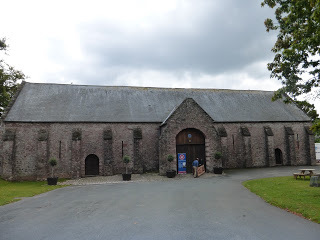
My first talk was in the Spanish Barn (photo immediately above) at Torre Abbey (photo at the top of this post), an atmospheric and historic setting, and I was gratified that the organisers had gathered an excellent crowd. I was introduced by David Brawn, my editor at Harper Collins, and my subject was The Golden Age of Murder. I didn't talk to a script, but after working on the book for so many years,I felt I would have more than enough to say without one! Some very interesting questions prompted a lively discussion, and I met several delightful people for the fist time.

In the afternoon, it was time to head off to the Imperial Hotel (said to be the model for the hotel in Peril at End House.) This time I was doing a double act with Rob Davies, from the publications department of the British Library. Rob is series editor for the BL's crime classics, and we talked about titles in this remarkably successful series (370,000 paperbacks sold so far!) as well as future plans. In a nutshell, we have titles lined up until the end of 2017. It seems like a long way ahead, but even then, the books will be appearing at a rate of more than one a month. Quite a schedule.
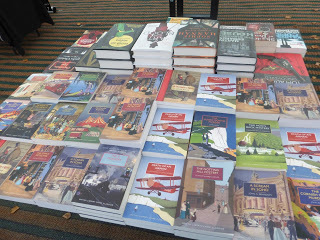
Rob and I both enjoyed the session, and we are hoping to repeat it at future festivals and other literary events in the future. One interesting aspect at Torquay was that the audience included some heirs of literary estates,and it was great to talk to them. Unexpectedly, Andrew Wilson, whose biography of Patricia Highsmith I reviewed here quite recently, came and said hello. We hadn't met before and I didn't know he lives in Devon. Andrew tells me he's written a new crime novel, which should be well worth looking out for. After two talks, I was more than ready for a convivial dinner with the British Library team, followed by a drink back in the Grand.
Then, the following morning, after goodbyes at Torre Abbey, it was off to Winchester, where I was talking about The Golden Age of Murder at Winchester Discovery Centre, a fabulous venue. Winchester is a lovely and, of course, very historic city, where the library is a proper community hub, and the schedule of events at the adjoining Discovery Centre is impressive. A model for libraries and associated services in the 21st century, I felt. This time, I was being interviewed by Gilbert Yates of the Discovery Centre, and the question and answer format made a refreshing change from a conventional talk. Next morning I satisfied my inner tourist with a sight-seeing trip around the city,and then it was off home after what had been, to say the least, an eventful week. One of many gratifying aspects of the trip was the enthusiasm shown by so many people for The Golden Age of Murder. I signed a lot of copies,and I remain bowled over by reaction to the book from so many people.
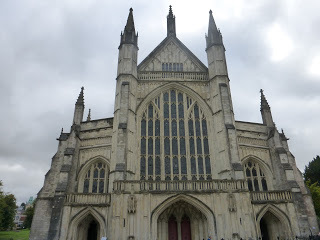
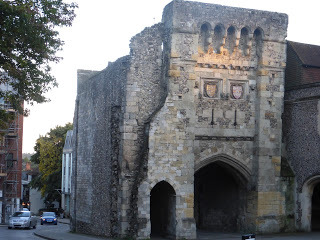
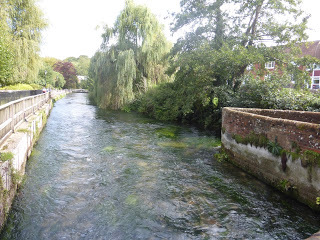
Published on September 23, 2015 07:00
September 21, 2015
Reprinting The Golden Age of Murder
I'm delighted to say that the hardback edition of The Golden Age of Murder has been reprinted. A few times in the past I've had a hardback novel reprinted after the original print run sold out, but in those cases the print run was considerably smaller. What accounts for this happy development? The quality and quantity of reviews are a big factor, I guess. And I'm also extremely grateful for the word-of-mouth recommendations that have helped the book to do so well.
These things do make a huge difference. Over the years I've written some books of which I was really proud which made only a limited impact in sales terms- Dancing for the Hangman in particular springs to mind, despite the great reviews it received. This time, I've received many more emails and even traditional letters from readers than for any other book. Even though The Golden Age of Murder isn't a novel, it's still a real thrill to find a large number of people responding to it so positively.
When the book was being prepared for publication, I must have driven the publishers crazy by making continual changes. I kept finding out new information, and dreaming up fresh things to say. You have to draw a line somewhere, but happily, my editor was very tolerant, and I like to think that the reaction to the book has justified my belief that it was worth doing everything I could do keep improving it.
But that process is potentially endless. The reprint has enabled me to include some additional items (three extra author photos, and also some new trivia for the end notes) and also to correct some printing and other errors that crept in - no doubt in part due to my constant tinkering. I don't think it's practicable with a book of such scale to eliminate every conceivable error, but I do feel very happy about the latest set of changes.
Will there be any more changes for the paperback edition, due out next May? Well, I continue to be enormously grateful to people who contact me with fresh snippets of info (and occasionally to point out typos) and please do keep them coming. The quest for perfection may be doomed to failure, but the true writer, I think, always wants to keep improving.
These things do make a huge difference. Over the years I've written some books of which I was really proud which made only a limited impact in sales terms- Dancing for the Hangman in particular springs to mind, despite the great reviews it received. This time, I've received many more emails and even traditional letters from readers than for any other book. Even though The Golden Age of Murder isn't a novel, it's still a real thrill to find a large number of people responding to it so positively.
When the book was being prepared for publication, I must have driven the publishers crazy by making continual changes. I kept finding out new information, and dreaming up fresh things to say. You have to draw a line somewhere, but happily, my editor was very tolerant, and I like to think that the reaction to the book has justified my belief that it was worth doing everything I could do keep improving it.
But that process is potentially endless. The reprint has enabled me to include some additional items (three extra author photos, and also some new trivia for the end notes) and also to correct some printing and other errors that crept in - no doubt in part due to my constant tinkering. I don't think it's practicable with a book of such scale to eliminate every conceivable error, but I do feel very happy about the latest set of changes.
Will there be any more changes for the paperback edition, due out next May? Well, I continue to be enormously grateful to people who contact me with fresh snippets of info (and occasionally to point out typos) and please do keep them coming. The quest for perfection may be doomed to failure, but the true writer, I think, always wants to keep improving.
Published on September 21, 2015 13:47
Burgh Island and a Day to Remember


I love islands, and this, combined with my love of Agatha Christie's books, means that for many years I've harboured the ambition to visit Burgh Island, off the coast of Christie's native Devon. It's a small tidal island with a fantastic Art Deco hotel where she stayed, as did many celebrities of her era. Burgh inspired Evil Under the Sun and also, though less directly, And Then There Were None. The Peter Ustinov film of Evil Under the Sun was not filmed on the island - at the time, the hotel had ceased to function as a hotel, and it seems to have operated as a sort of very upmarket holiday camp. But the hotel was restored, and provided the setting for the David Suchet version of the story. These days it's very luxurious - so much so that an extended stay was financially out of the question. But when I was invited to the Agatha Christie Festival in nearby Torquay, I resolved to stay on Burgh the night before.
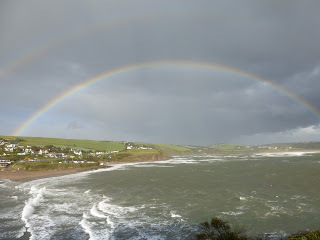


My excitement mounted when news came from the hotel that a tropical storm was forecast for the night of my visit. What could be more atmospheric? At low tide, you can walk across the sand from the mainland to Burgh, but at high tide there is a sea tractor, an elaborate and rather rickety-looking contraption, which ferries people back and forth. However, the storm meant that the sea tractor would be unsafe, so it was essential to get there in time for luggage etc to be taken across the sand before the water came in.
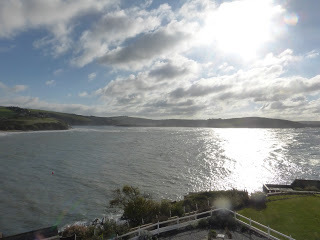


In order to break the journey, I stayed overnight in Somerset. A good idea in theory,but it proved disastrous in practice, as the hotel's breakfast cafetiere exploded, showering me in hot coffee, an incident that led to my being covered by ice packs for an hour. However, I hated the idea of giving up on Burgh, and it was actually easier to soldier on and drive there than go all the way home. And am I glad I took that decision!


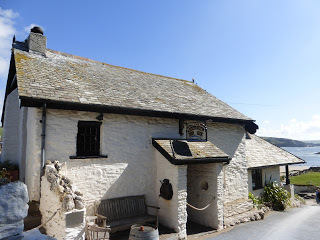
The island was wonderful, and so was the hotel - my room was one used for filming Evil Under the Sun, which was a real bonus. Truly a glimpse into how the other half live. The storm didn't really materialise, but a fantastic rainbow decorated the early evening sky, and the next morning was brilliantly sunny. Mind you, fellow guests may have been rather spooked by the sight of a mysterious disfigured stranger at dinner. Never mind. It was a truly unforgettable occasion, for all sorts of reasons, most of them very pleasurable indeed..

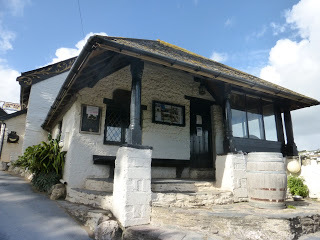



.
Published on September 21, 2015 01:13
September 18, 2015
Forgotten Book - The Undetective
Bruce Graeme (1900-82) was a Golden Age writer who enjoyed a long and prolific career, yet until recently I'd never read any of his books as far as I can recall. Then Geoff Bradley, editor of CADS, recommended that I take a look at The Undetective (1962), telling me that it was an unusual story that he really enjoyed. Having just read the book, I share Geoff's view, and I suspect it's a good example of an original story that stands above and apart from most of the work of an author who was a talented storyteller, perhaps wrote too much to reach the heights on a regular basis.
Iain Carter is a happily married crime writer who is struggling to make a decent living. His lovely wife Susan (so lovely, in fact, that I became slightly irritated by the repeated references to her perfection) has a likeable brother who happens to be a slightly indiscreet policeman. Iain stumbles on the idea of writing a new series of books which make innovative use of information gleaned from his brother-in-law. But to protect his identity, he goes to very elaborate lengths indeed to create a pseudonym that cannot be traced to him.
His first book under the new pen-name, The Undetective, proves to be a huge success, and Iain finds himself having to take increasingly convoluted measures to protect his secret. The plot complications thicken when a murder occurs, and the mysterious and pseudonymous crime writer becomes a prime suspect.
An especially pleasing bonus of the story is that Graeme adds copious references to the Crime Writers' Association - one scene even takes place at a CWA meeting. Various CWA members of the time,s such as Michael Gilbert, T.C. H. Jacobs and Margot Bennett, earn a mention. He even includes a dig at Julian Symons, who reviews unkindly one of the books Iain continues to publish under his own name. The plot is, admittedly, implausible, but there is a very neat solution, and it all makes for a very good read. This is a Forgotten Book that undoubtedly deserves to be better known.
Iain Carter is a happily married crime writer who is struggling to make a decent living. His lovely wife Susan (so lovely, in fact, that I became slightly irritated by the repeated references to her perfection) has a likeable brother who happens to be a slightly indiscreet policeman. Iain stumbles on the idea of writing a new series of books which make innovative use of information gleaned from his brother-in-law. But to protect his identity, he goes to very elaborate lengths indeed to create a pseudonym that cannot be traced to him.
His first book under the new pen-name, The Undetective, proves to be a huge success, and Iain finds himself having to take increasingly convoluted measures to protect his secret. The plot complications thicken when a murder occurs, and the mysterious and pseudonymous crime writer becomes a prime suspect.
An especially pleasing bonus of the story is that Graeme adds copious references to the Crime Writers' Association - one scene even takes place at a CWA meeting. Various CWA members of the time,s such as Michael Gilbert, T.C. H. Jacobs and Margot Bennett, earn a mention. He even includes a dig at Julian Symons, who reviews unkindly one of the books Iain continues to publish under his own name. The plot is, admittedly, implausible, but there is a very neat solution, and it all makes for a very good read. This is a Forgotten Book that undoubtedly deserves to be better known.
Published on September 18, 2015 05:27
September 16, 2015
The Long Siesta - guest blog by Nick Sweet
I'm down in Torquay today, taking part in the Agatha Christie Festival, of which more before long. In the meantime, here's a guest blog from Nick Sweet:
"Apart from having its Spanish detective, Inspector Velázquez, wrestle with a heroin habit, my new crime thriller, The Long Siesta, is unusual because there is a sense in which the history of the Spanish Civil War finds itself being rewritten within its pages. Actually this is all dealt with in the ‘book within the book’ that I worked into the novel.
Let me explain. It is often argued by historians that the Civil War might not have taken place at all had General Franco not been able to make his way over to Las Palmas, from where he could easily fly to Readers of The Long Siesta will be happy to have this question answered for them; because—surprise! surprise!—it happens that one of the characters in my novel turns out to be the General’s killer. Balmes’ death, in fact, as arranged by my character (whose identity I’d better keep in the dark, to avoid ruining the story for readers), facilitates the start of the Civil War. Strangely, perhaps—or perhaps not so strangely—my killer is motivated by love. He threatens to ‘kill somebody important’ if the girl he lives won't have him; and, well, despite being fond of him, she is young and feels overwhelmed by his advances, so she refuses him. Her decision ultimately leaves her wondering whether the Civil War might have been averted, had she only been a little less timid.
I wanted to link episodes which took place during the Civil War (which of course raged from 1936 to 1939), with events in the more recent past (in this case, the summer of 1998); and managed to find a way of doing this that focused on a killer who was busy murdering priests in Seville in the most violent and gruesome fashion imaginable. In Spain the Catholic Church has always played an important part in the life of its citizens, and it also played a key role in the Civil War; so I wanted to bring the clergy into the novel.
I was lucky, in that my reading of history—in this case, Paul Preston’s magnum opus on General Franco—provided me with a true to life murder mystery that has yet to be solved to this day. I took this as a way in, without really knowing where I was headed; then, after a priest is found dead in his own home on Seville’s Calle Viriato (apparently after calling an escort agency and asking for a gay young man to be sent over to his place), a second priest shows up in the Guadalquivir. Are the two murders linked? Well, Inspector Jefe Velázquez is convinced they are, and he sets out to investigate… And while he was about it, he dragged yours truly along after him as I clung to his coat tails."
Thanks, Nick, and best of luck with the book.
"Apart from having its Spanish detective, Inspector Velázquez, wrestle with a heroin habit, my new crime thriller, The Long Siesta, is unusual because there is a sense in which the history of the Spanish Civil War finds itself being rewritten within its pages. Actually this is all dealt with in the ‘book within the book’ that I worked into the novel.
Let me explain. It is often argued by historians that the Civil War might not have taken place at all had General Franco not been able to make his way over to Las Palmas, from where he could easily fly to Readers of The Long Siesta will be happy to have this question answered for them; because—surprise! surprise!—it happens that one of the characters in my novel turns out to be the General’s killer. Balmes’ death, in fact, as arranged by my character (whose identity I’d better keep in the dark, to avoid ruining the story for readers), facilitates the start of the Civil War. Strangely, perhaps—or perhaps not so strangely—my killer is motivated by love. He threatens to ‘kill somebody important’ if the girl he lives won't have him; and, well, despite being fond of him, she is young and feels overwhelmed by his advances, so she refuses him. Her decision ultimately leaves her wondering whether the Civil War might have been averted, had she only been a little less timid.
I wanted to link episodes which took place during the Civil War (which of course raged from 1936 to 1939), with events in the more recent past (in this case, the summer of 1998); and managed to find a way of doing this that focused on a killer who was busy murdering priests in Seville in the most violent and gruesome fashion imaginable. In Spain the Catholic Church has always played an important part in the life of its citizens, and it also played a key role in the Civil War; so I wanted to bring the clergy into the novel.
I was lucky, in that my reading of history—in this case, Paul Preston’s magnum opus on General Franco—provided me with a true to life murder mystery that has yet to be solved to this day. I took this as a way in, without really knowing where I was headed; then, after a priest is found dead in his own home on Seville’s Calle Viriato (apparently after calling an escort agency and asking for a gay young man to be sent over to his place), a second priest shows up in the Guadalquivir. Are the two murders linked? Well, Inspector Jefe Velázquez is convinced they are, and he sets out to investigate… And while he was about it, he dragged yours truly along after him as I clung to his coat tails."
Thanks, Nick, and best of luck with the book.
Published on September 16, 2015 04:46
September 14, 2015
The CWA Dagger Reads
The Crime Writers' Association undertakes a very wide range of activities on behalf of its members, and from quite an early point in its existence, back in the Fifties, the CWA has sought to promote crime writing generally - in the belief that celebrating the best books in the genre is widely beneficial, because it interests and enthuses readers up and down the country and much further afield.
One of the latest initiatives is "the CWA Dagger Reads", which is a starting out as an online venture aimed at giving readers a voice as regards those sought-after awards, the CWA Daggers. The growing connection between readers and writers has already seen the creation of the Crime Readers' Association, which now has thousands of members, and the CWA Dagger Reads is another element in the strategy of making use of the internet to increase connections, and awareness of the enjoyability of the genre.
What the CWA is doing is trialling this idea in relation to its final three awards of the year - the CWA Gold Dagger for fiction, the CWA John Creasey Dagger, and the CWA Ian Fleming Steel Dagger. On the CWA Dagger Reads website there is a good deal of info about each of the books that have been short-listed for these Daggers. The hope is that this will encourage discussion among readers and further enhance the profile of the books in question.
The Daggers will be awarded at a ceremony in London on 29 September that I'm looking forward to attending. Te current plan is to extend the project to all books short-listed for CWA Daggers next year. Possible developments include events at literary festivals, and that idea seems to me to be well worth exploring, not least because the more that these events spread out from London to the rest of the country, making it easier and cheaper for many crime fans to become involved, the better. But that's for the future. In the meantime, I'm glad that this venture is up and running online.
One of the latest initiatives is "the CWA Dagger Reads", which is a starting out as an online venture aimed at giving readers a voice as regards those sought-after awards, the CWA Daggers. The growing connection between readers and writers has already seen the creation of the Crime Readers' Association, which now has thousands of members, and the CWA Dagger Reads is another element in the strategy of making use of the internet to increase connections, and awareness of the enjoyability of the genre.
What the CWA is doing is trialling this idea in relation to its final three awards of the year - the CWA Gold Dagger for fiction, the CWA John Creasey Dagger, and the CWA Ian Fleming Steel Dagger. On the CWA Dagger Reads website there is a good deal of info about each of the books that have been short-listed for these Daggers. The hope is that this will encourage discussion among readers and further enhance the profile of the books in question.
The Daggers will be awarded at a ceremony in London on 29 September that I'm looking forward to attending. Te current plan is to extend the project to all books short-listed for CWA Daggers next year. Possible developments include events at literary festivals, and that idea seems to me to be well worth exploring, not least because the more that these events spread out from London to the rest of the country, making it easier and cheaper for many crime fans to become involved, the better. But that's for the future. In the meantime, I'm glad that this venture is up and running online.
Published on September 14, 2015 01:30



